Content
Published:
This is an archived release.
Hazardous waste outgrowing both GDP and the population
A total of 1.38 million tonnes of hazardous waste were sent for approved treatment in 2014 – an increase of around 70 per cent compared to 2003. In comparison, gross domestic product (GDP) and the population have only increased by 20 and 13 per cent respectively during the same time period.
| 2014 | 2013 | 2010 | Change in per cent | ||
|---|---|---|---|---|---|
| 2013 - 2014 | 2010 - 2014 | ||||
| Total | 1 376 | 1 238 | 1 164 | 11.1 | 18.2 |
| Waste containing oil | 478 | 461 | 450 | 3.7 | 6.2 |
| Waste containing solvents | 33 | 31 | 28 | 6.5 | 17.9 |
| Other organic waste | 41 | 33 | 36 | 24.2 | 13.9 |
| Waste containing heavy metals, polluted matter | 479 | 383 | 404 | 25.1 | 18.6 |
| Corrosive waste | 312 | 282 | 208 | 10.6 | 50.0 |
| Other inorganic hazardous wastes | 9 | 9 | 7 | 0.0 | 28.6 |
| Processing water | 22 | 37 | 27 | -40.5 | -18.5 |
| Photo chemicals | 1 | 1 | 1 | 0.0 | 0.0 |
| Nonclassified hazardous waste | 1 | 1 | 3 | 0.0 | -66.7 |
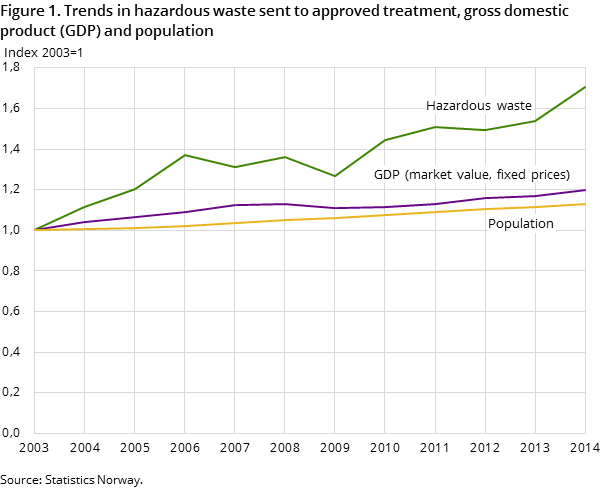
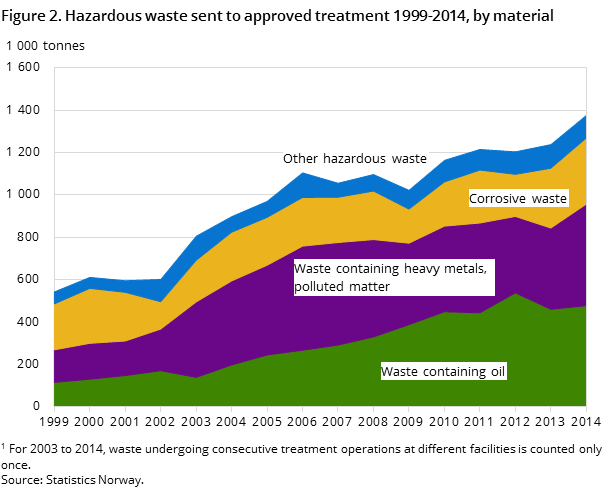
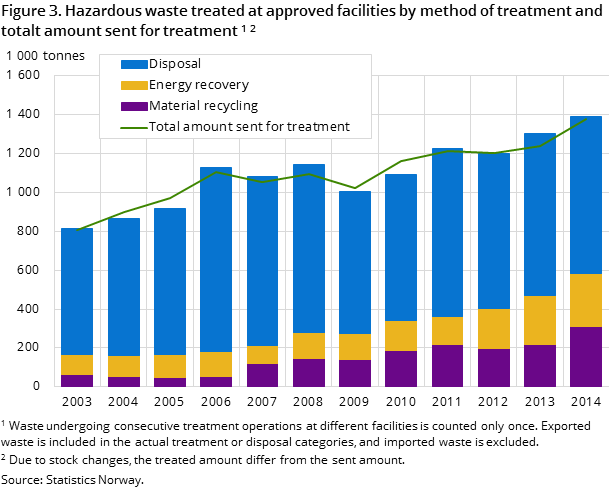
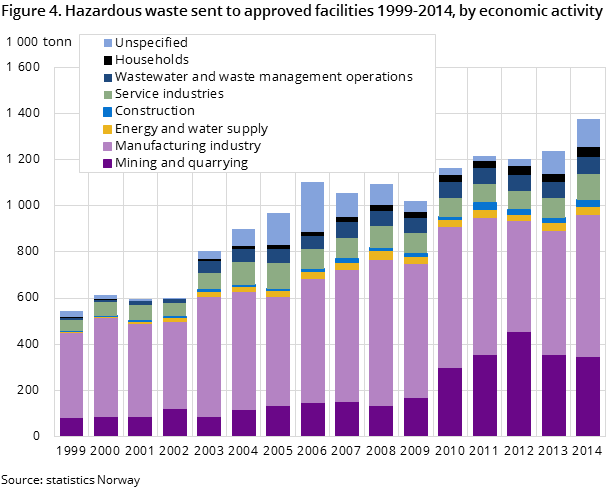
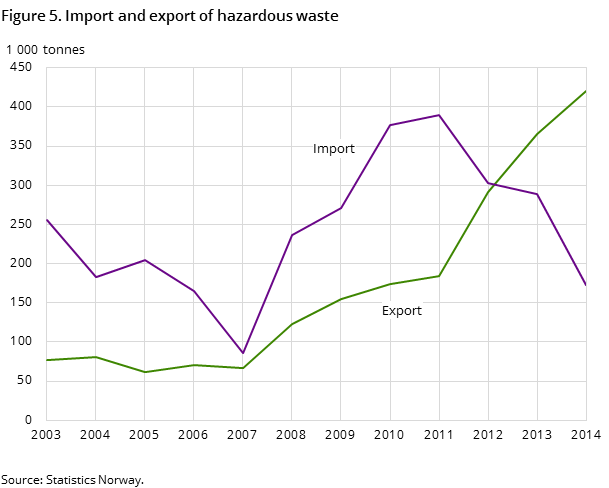
Thus, the general trend is that hazardous waste sent for approved treatment is relatively high compared to the growth in the economy and population growth.
Simply put, by dividing the 1.38 million tonnes sent from all sectors of society for approved treatment by the population, it gives an average of around 270 kg of hazardous waste per person in 2014.
97 per cent to approved treatment
Hazardous waste contains substances that are hazardous both to health and the environment. Thus, it is important to ensure that as much as possible of the hazardous waste is subject to proper treatment in order to avoid harming people and the environment.
In addition to the 1.38 million tonnes sent for approved treatment, estimates are also made of the amount of hazardous waste sent for unknown treatment. This amount has been estimated at around 43 000 tonnes in 2014. Consequently, out of the estimated total amount generated, 97 per cent is believed to be sent for approved treatment, while the remaining 3 per cent is sent for unknown treatment and is beyond ‘governmental control’.
Around 42 per cent of the approved waste treatment was recovered, i.e. either recycled (23 per cent) or energy recovered (19 per cent). The remaining 58 per cent was disposed of. Exports of hazardous waste are included in these figures, but imports are not.
Further increase in export of hazardous waste
There has been a noticeable increase in exported amounts of hazardous waste in recent years. In 2014, Norway sent 420 000 tonnes out of the country for treatment abroad; an increase of 15 per cent compared to the year before. Simultaneously, Norway imported 170 000 tonnes of hazardous waste from abroad; down 40 per cent compared to the year before.
Imports are dominated by waste containing heavy metals and polluted mineral matter destined for landfilling in Norway. Exports, on the other hand, are mainly made up of various types of oil-containing hazardous waste, process water and heavy metal-containing waste.
The import and export of hazardous waste requires approval by the authorities in order to ensure proper treatment in the receiving country.
Oil and heavy metal-containing waste dominate
In 2014, oil-containing and heavy metal-containing waste were the two dominant groups of hazardous waste, with around 480 000 tonnes each sent for approved treatment. Oil-containing waste mostly includes waste from oil drilling activities on the Norwegian shelf, while heavy metal-containing waste consists of slag, dust and ashes from the manufacturing industry, but also CCA-impregnated wood, batteries and used sand from grit blasting.
620 000 tonnes from manufacturing
Manufacturing industries sent 620 000 tonnes of hazardous waste for approved treatment in 2014, including treatment in their own facilities. This makes up around 45 per cent of all hazardous waste in Norway. Another main contributor - with almost 340 000 tonnes - is the mining and quarrying industry, which includes oil extraction activities.
It has been estimated that households accounted for around 40 000 tonnes of hazardous waste sent for approved treatment in 2014 (based on declarations of hazardous waste). On average, this constitutes around 8 kg per person. Impregnated wood, paint residues and waste oil constitute the main components.
Less hazardous waste from Svalbard
The amount of hazardous waste from Svalbard varies from year to year. In recent years, between 100 and 300 tonnes of hazardous waste have been sent annually for approved treatment. In 2014, the amount was 160 tonnes, of which almost 72 per cent was made up of oil-containing waste. Hazardous waste from Svalbard is transported to the mainland for treatment there.
Additional information
Approved treatment as applied in this article includes only hazardous waste generated in Norway (export is therefore included, while import is excluded).
Contact
-
Gisle Berge
E-mail: gisle.berge@ssb.no
tel.: (+47) 48 12 19 97
-
Terje Lorentzen Landsem
E-mail: terje.landsem@ssb.no
tel.: (+47) 98 84 31 39
